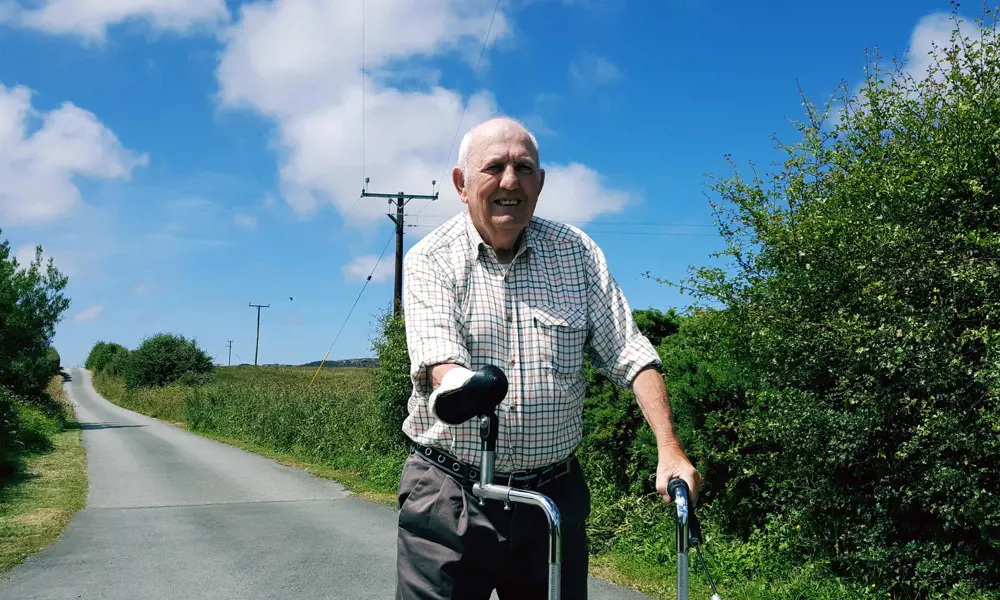
Tailor-made inventions
Engineers have always been called upon to help disabled people. Over the years, they have been instrumental in providing a range of targeted, specialised equipment such as prosthetics, robotic systems, MRI scanners, and manual and motorised wheelchairs, beds and hoists.
For the last 50 years, UK charity Remap has harnessed the expertise of voluntary engineers to pick up where manufactured equipment often falls short. It has helped individuals customise their equipment or created bespoke solutions to enable them to take part in day-to-day activities.
The charity has now partnered with BBC programme The Big Life Fix, which shows inventors finding ways to help disabled people to lead more independent and fulfilling lives. Remap helps the BBC in the planning stages to make sure projects are feasible and then, when the cameras are gone, the charity takes on the aftercare, ensuring that any adaptations or breakages are rectified for the individual or their families.
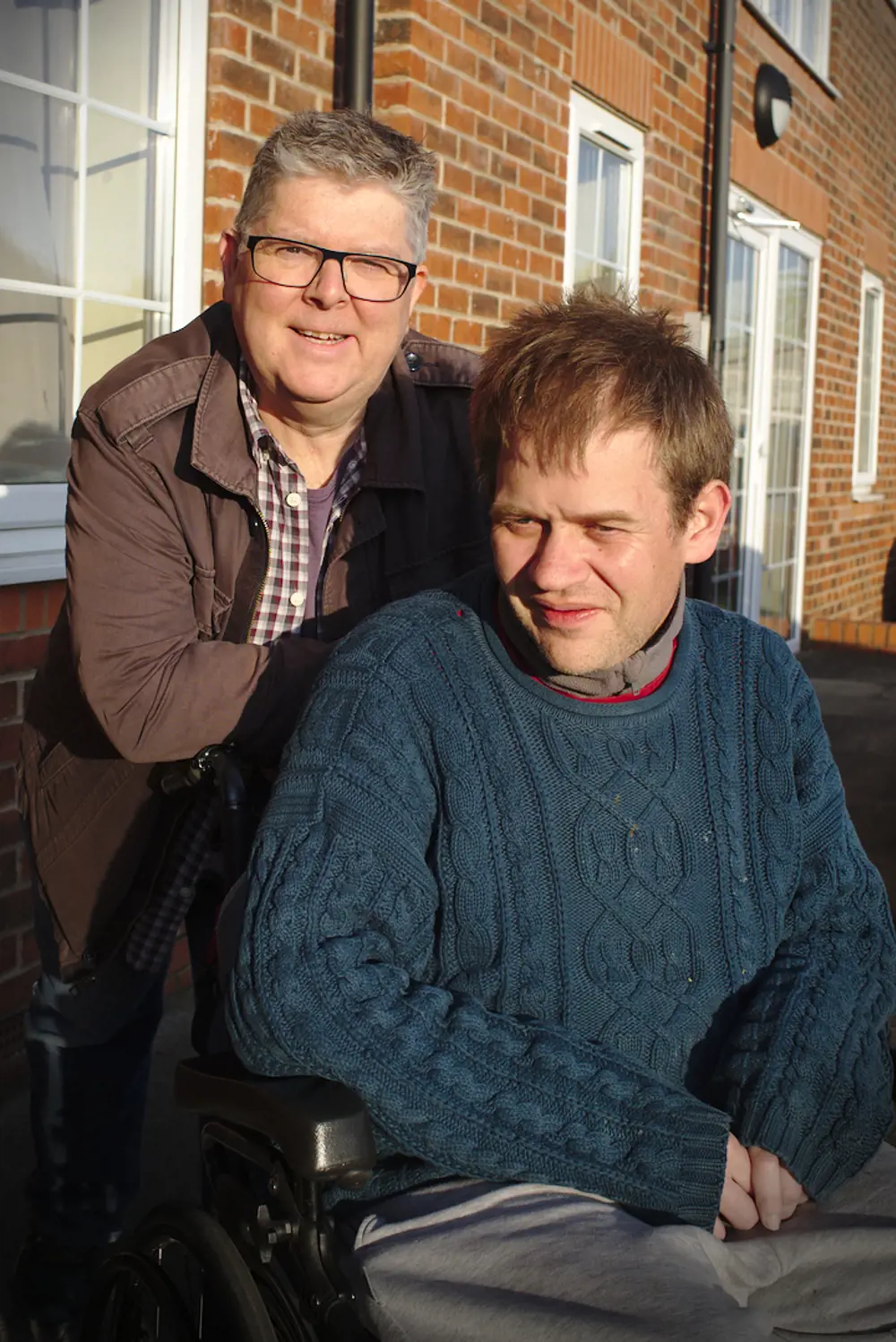
Rupert with Ian. The modified virtual reality headset that the engineer developed for Ian was recognised at the 2018 Remap awards © Remap
Enhanced vision
Rupert Powell became a volunteer with Remap after watching an episode of The Big Life Fix with his wife. The programme showed a young man who wanted to take photographs but whose acute skin condition meant that he couldn’t hold a camera. After seeing an engineer who worked for Lego find a solution, Rupert’s wife said “you could do that” and so he took note of Remap’s details on the closing credits and contacted his local York branch to see if he could help out.
Rupert’s day job is with the international electronics company Extron, which makes audio and video control systems. He is a product manager for remote controls and also trains people in writing software. His hands-on engineering was limited to his amateur astronomy interests, so he was looking forward to building and adapting specialised equipment for disabled people.
The main criteria for creating Ian’s personalised video system were to make it compact, balanced, light and able to work in real-time. The camera had to be self-operating as it would be too difficult to continually hold. Rupert originally mounted it on the front of the VR headset with a strap holding the whole unit on and a separate box holding the workings in a shoulder bag but there were too many wires floating around and the headset was top heavy. So, the current Mark 2 version was reconfigured, placing the camera on top of a ski helmet and encasing wiring and components.
The camera is a modified webcam that now has a CCTV lens on it because Ian needs telephoto zoom to get closer to the action – webcams are usually built for close up wide-angle work. The camera has 1080 pixel resolution and is streamed on USB 2.0 down the same cable as the HDMI (high-definition multimedia interface) back to the central processing box.

Ian wearing his helmet with a modified webcam (left) that is controlled by a wireless PlayStation controller (right)
The brain of the box is a Raspberry Pi 3 which relays very close to real-time video to the screen – there are only a couple of hundred milliseconds of delay. There is also a battery backup system for the Raspberry Pi so that it can be switched on and off with an ordinary toggle switch. The whole system is powered by a graphene battery (lithium polymer chemistry effectively), which is the latest technology used for remote-operated vehicles. It is very light with 5.2 amp-hours (AH) capacity and is charged with a built-in smart charger.
The wireless handset that links to this system has numerous buttons. One allows the picture to go negative, another increases the contrast. Another button activates a freeze-frame function that allows Ian to study a particular moment in play or to read text. A further button enables edge-detection to help him study text. The handset also allows the user to zoom in on subjects with either optical zoom or pixel zoom, or both.
The software to connect it all together was written in Python3 and uses Open CV video processing library. A Genie programming editor was used to write the code that comes as standard in Linux with the addition of a Pygame library for the game control handset. There’s an RS232/USB connection to the Arduino lens control, and all this functions with just 150 lines of code.
Isn’t it amazing that spending just an hour or two in your garage on a Saturday morning can change someone’s life!
Enabling Engineers
🤝 Remap charity’s origin story and UK community of 'makers'
Remap began in 1964 when an Imperial Chemical Industries (ICI) employee installed a ramp and ceiling hoist for his sister who had polio, in the days before these were available at home. Volunteer engineers from the Teesside chemical plant, both retirees and employees, then helped other people in the area with adaptations and bespoke remedies to challenges they faced.
It used to be that occupational therapists (OTs) provided the majority of clients but, now that Remap is fairly well known, it is roughly a 50–50 split between self-referrals and OT-recommended patients. Although the average cost per innovation is £70, there is no charge to the disabled person and no payment, apart from material expenses, for the Remap enablers.
Remap has 73 local groups nationwide with 1,000 volunteers carrying out 3,500 bespoke projects a year. The volunteers mostly consist of retired and working engineers, woodworkers, electricians, medical practitioners and ‘makers’ – people who design and make things. They work from home, a garage, a shed, at a firm’s workshop, in a maker-space, in university laboratories or wherever there is access to milling, lathing, 3D-printing or machinery that will enable a gadget to be made or adapted
Local groups meet monthly or bi-monthly and discuss new enquiries, allocate projects, report on adaptations they are working on, and discuss possible solutions to problems they encounter. The scope of requests is wide-ranging. Remap will not help if there is already a product that exists to do the job, but otherwise there is pretty much no limit.
The charity gets no government backing and fundraises through the local groups giving talks and by appealing directly to trusts. Remap is still looking to increase the number of tasks it carries out each year and to add to the number of volunteers on its books.
For more information about the charity or volunteer, visit their website.
It took six months to create and test the vision enhancement headset with Ian’s comments considered at each iteration. Now, Ian can not only watch football at Anfield – he is a wheelchair user and has a good position near the halfway line – he also uses the headset for day-to-day tasks such as shopping. Before, he would have to ask people where a certain aisle was and then had to pick up a multitude of tins to read the labels closely before he found the right one; now he can scan aisles and items from his chair.
The Royal National Institute for the Blind has expressed an interest in the headset and RS Components, the main distributor for Raspberry Pi and a lot of the components within the innovation, have asked Rupert to produce five more to see if other people can benefit from it. Rupert is not interested in patenting the device, in fact he has placed videos on YouTube detailing how it was made. He says that his kick comes from working out a problem with an end user and then making it happen: “Isn’t it amazing that spending just an hour or two in your garage on a Saturday morning can change someone’s life!”
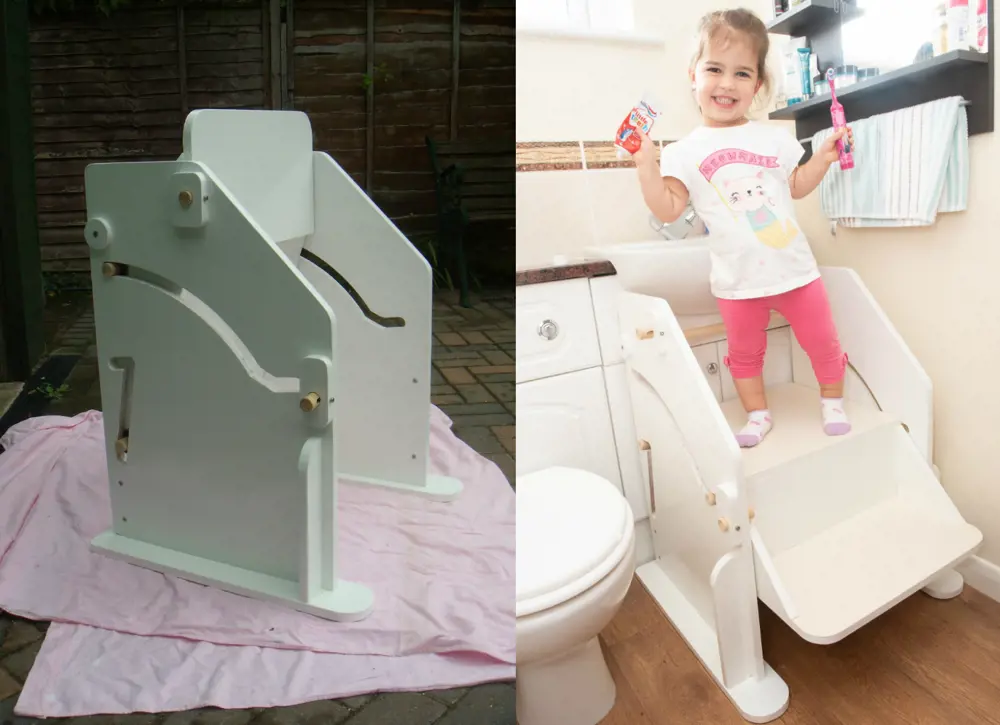
The step platform locked in up position (left) and Margaux with steps locked down (right) © Pictoria
Helping Margaux
Ralph Anderson, a mechanical engineer working part time, heard about Remap through reading a short article in Professional Engineer. His paid work is mostly office-based so he wanted a chance to put his practical expertise and the tools in his well-stocked garden shed to good use. He had an interview with the Derby group five years ago and was invited to join its monthly meetings. In 2016, one of the referrals was from an occupational therapist at Derby Children’s Hospital for a patient called Margaux.
Margaux has skeletal dysplasia (dwarfism) and needed adaptable steps in her bathroom to reach the washbasin. Her parents live in a rented house, which meant that no fastening could be made to the bathroom wall or floor and the existing sink and cupboards could not be altered. Her mother told Ralph that she wanted Margaux to be able to operate a step platform herself and she wanted it to be foldable to that her husband could shave from the same sink.
The result is that Margaux has gained some independence and the steps have won Ralph a special mention from Remap at its 2018 awards
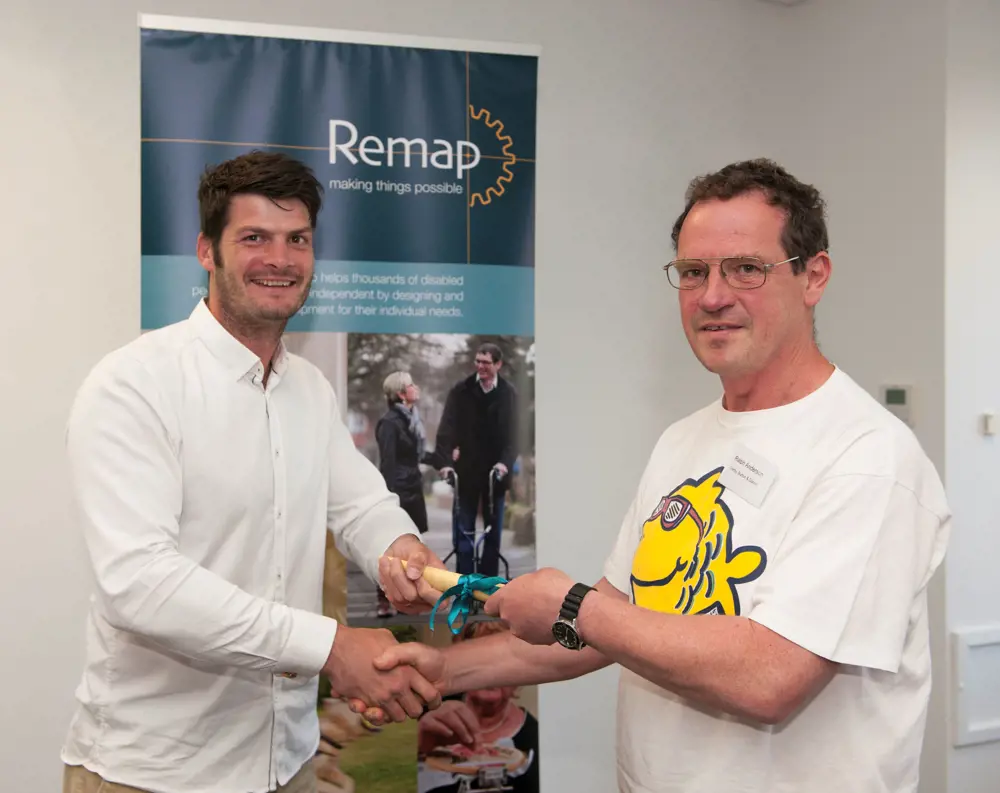
Dave Henson MBE, bioengineer and Paralympian, presents a Remap award to Ralph Anderson for his step and platform design in June 2018 © Remap
Ralph made a concept sketch for the family to check before proceeding and then made the steps out of 18-millimetre plywood and 25-millimetre diameter softwood dowels. He made small captive bolt mechanisms so that the dowel has to be pushed across to either lock it up or down by Margaux herself. Solid furniture wax was used to help it operate smoothly, which doesn’t leave a mess and lubricates well for a long time.
The interlocks on the steps meant that the steps couldn’t drop inadvertently or trap Margaux’s fingers and the slots cut into the frame meant that the step could only travel on one path. For adults, it folds up out of the way but is always in place under the basin, available for Margaux. Ralph applied an oil-based undercoat and gloss to finish, using an eggshell paint for the tops of the treads and mixing some fine sand into it to give a non-slip surface that could be easily cleaned.
The result is that Margaux has gained some independence and the steps have won Ralph a special mention from Remap at its 2018 awards.
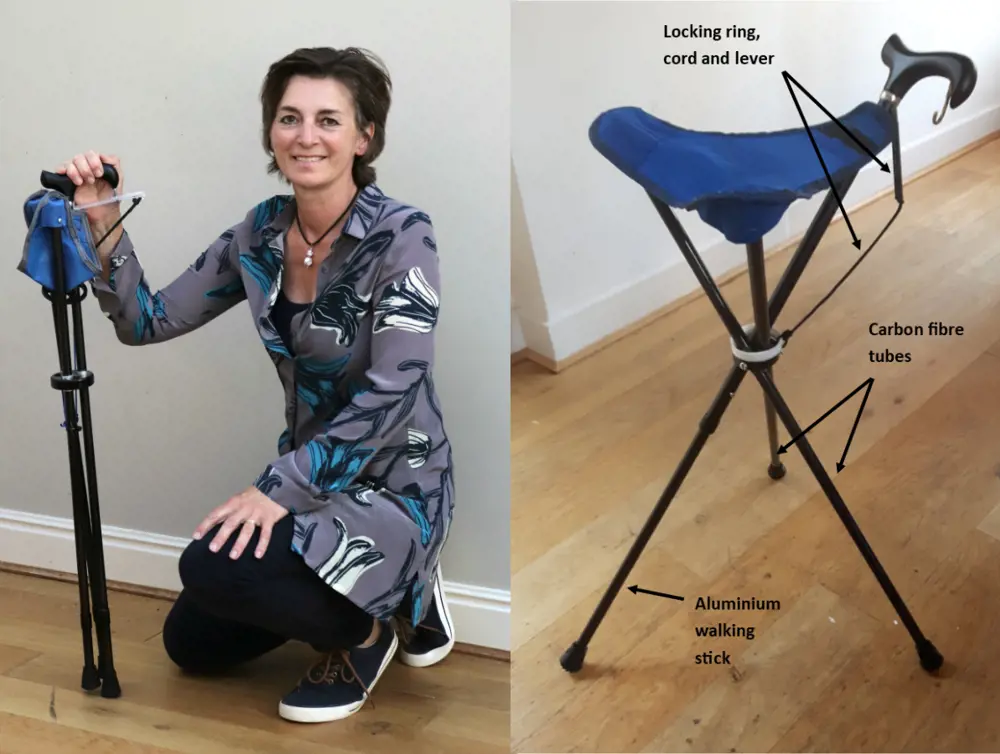
Caryn Moberly with her stick stool in the closed position (left) and the stick stool in open position (right)
Walking more comfortably
Caryn Moberly has been a volunteer with the Berkshire Remap group for two years now. She trained as a furniture maker and has helped develop a solution for a woman with multiple sclerosis who walks with two sticks. The woman needs to pause and sit when out walking, so the seat Caryn designed had to attach to one of the client’s sticks. It had to be solid and stable when open, very lightweight and quite high so that she could get up from it easily. The stick would have to convert to a stool and back into a stick with one hand as the other would be holding her second stick.
Caryn based her solution on a fisherman’s stool and took from it the hinge element. She adapted an aluminium walking stick and then added two carbon fibre rods slightly shorter than the stick. She worked with engineers from the Henley Inventors Club to strengthen the pivot points and the stool is kept in the closed position with a locking ring attached by a cord to a lever.
The combined folding perching stool and walking stick weighs 600 grams and has proved very popular. The design has had several improvements: the legs are fully closed when used as a walking stick; the stick can easily be turned into a stool with one hand; and the stool can be locked into position when needed. People who have had a stroke and a hip replacement have benefited from it too. Caryn is now looking to patent the perfected design and get funding to produce more stick stools.
Changing lives
The thousands of adaptations and innovations made each year by Remap engineers are now being uploaded onto a huge, free, online database, which includes drawings, photos and descriptions, so that volunteers and other interested people around the world can devise their own bespoke solutions.
You may think that the things that you do are small and that anyone could do them, but they were a big part of making his life better
The last words come from the parents of James Dunn, the 22-year old who was terminally ill and featured on the episode of The Big Life Fix that inspired Rupert Powell to become a volunteer. James, who had a chronic terminal condition that meant that his skin peeled off and left him in great pain, needed more help with his camera and so Rupert worked with him for 18 months helping with his photography. James wanted to take pictures to leave a legacy and found focusing on them distracted him from his pain. James died in May 2018 and his father approached Rupert at the funeral to say: “You may think that the things that you do are small and that anyone could do them, but they were a big part of making his life better.”
***
This article has been adapted from "Tailor-made inventions", which originally appeared in the print edition of Ingenia 76 (September 2018).
Contributors
Dominic Joyeux
Author
Keep up-to-date with Ingenia for free
SubscribeRelated content
Design & manufacturing
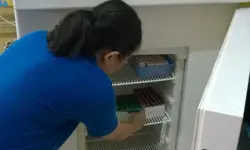
Super cool(er)
Welsh startup Sure Chill has developed a cooler that uses the properties of water to keep its contents cool for around 10 days without electricity. This is ideal for storing items such as vaccines where electricity sources are unreliable.
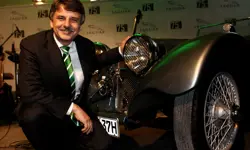
R&D investment makes good business sense
In just five years, Dr Ralf Speth FREng has presided over a revolution in design and manufacturing that has helped create a new family of engines and has overhauled Jaguar Land Rover (JLR) production facilities.

Steel can arise from the ashes of coal
Thousands of people were laid off in the UK steel industry in 2015 and there are pessimistic future forecasts. Professor Sridhar Seetharaman of the Warwick Manufacturing Group argues that smaller, flexible steel mills implementing new technology would better cope with fluctuating global trends.
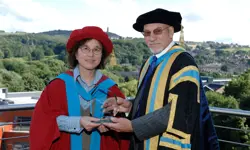
Integrating metrology in business and academe
Professor Jane Jiang’s interest in measuring began when she worked on a bus production line in China. She found that the best way to improve quality, consistency and productivity was through metrology, the science of measurement. Today, she runs the UK’s largest metrology research group.
Other content from Ingenia
Quick read

- Environment & sustainability
- Opinion
A young engineer’s perspective on the good, the bad and the ugly of COP27

- Environment & sustainability
- Issue 95
How do we pay for net zero technologies?
Quick read

- Transport
- Mechanical
- How I got here
Electrifying trains and STEMAZING outreach

- Civil & structural
- Environment & sustainability
- Issue 95